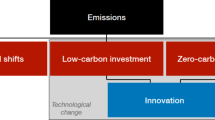Abstract
In 2007 Nicholas Stern’s Review (in Science 317:201–202, 2007) estimated that global GDP would shrink by 5–20% due to climate change which brought forth calls to reduce emissions by 30–70% in the next 20 years. Stern’s results were contested by Weitzman (in J Econ Lit XLV(3):703–724, 2007) who argued for more modest reductions in the near term, and Nordhaus (in Science 317:201–202, 2007) who questioned the low discount rate and coefficient of relative risk aversion employed in the Stern Review, which caused him to argue that ‘the central question about global-warming policy—how much how, how fast, and how costly—remain open.’ We present a simulation model developed by Färe et al. (in Time substitution with application to data envelopment analysis, 2009) on intertemporal resource allocation that allows us to shine some light on these questions. The empirical specification here constrains the amount of undesirable output a country can produce over a given period by choosing the magnitude and timing of those reductions. We examine the production technology of 28 OECD countries over 1992–2006, in which countries produce real GDP and CO2 using capital and labor and simulate the magnitude and timing necessary to be in compliance with the Kyoto Protocol. This tells us ‘how fast’ and ‘how much’. Comparison of observed GDP and simulated GDP with the emissions constraints tells us ‘how costly’. We find these costs to be relatively low if countries are allowed reallocate production decision across time, and that emissions should be cut gradually at the beginning of the period, with larger cuts starting in 2000.








Similar content being viewed by others
Notes
Each country’s optimal growth rate can be used to estimate the social rate of time preference given suitable choices for the coefficient of relative risk aversion and the rate of individual time preference.
References
Aldy JE, Stavins RN (2008) Climate policy architectures for the post-kyoto world. Environment 50(3):8–17
Azomahou T, Laisney F, Nguyen Van P (2006) Economic development and CO2 emissions: a nonparametric panel approach. J Public Econ 90:1347–1363
Barrett S (2009) The coming global climate-technology revolution. J Econ Perspect 23(2):53–75
Boden T, Marland G, Andres RJ (2009) National CO2 emissions from fossil-fuel burning, cement manufacture, and gas flaring: 1751–2006. Carbon Dioxide information analysis center, Oak Ridge National Laboratory. http://cdiac.ornl.gov/trends/emis/tre_coun.html
Bosetti V, Frankel J (2009) Global climate policy architecture and political feasibility: specific formulas and emission targets to attain 460 ppm CO2 concentrations. Fondazione Eni Enrico Mattei, sustainable development series 92.2009. http://ssrn.com/abstract=1515780
Copeland BR, Taylor MS (2004) Trade, growth, and the environment. J Econ Lit XLII: 7–71
Environmental Protection Agency (2009) Inventory of US greenhouse gas emissions and sinks: 1992–2007. US Environmental Protection Agency
European Environment Agency (2006) Greenhouse gas emission trends and projections in Europe 2006. EEA Report No. 9/2006
Färe R, Grosskopf S, Noh D-W, Weber W (2005) Characteristics of a polluting technology: theory and practice. J Econom 126:469–492
Färe R, Grosskopf S, Margaritis D (2009) Time substitution with application to data envelopment analysis. Mimeo
Heil MT, Selden TM (2001) Carbon emissions and economic development: future trajectories based on historical experience. Environ Dev Econ 6:63–83
Heston A, Summers R, Aten B (2009) Penn world table version 6.3, Center for international comparisons of production, income and prices at the University of Pennsylvania, August 2009
Holtz-Eakin D, Selden TM (1995) Stoking the fires? CO2 emissions and economic growth. J Public Econ 57:85–101
Jaffe AB, Newell RG, Stavins RN (2005) A tale of two market failures: technology and environmental policy. Ecol Econ 54:164–174
Jeon BM, Sickles RC (2004) The role of environmental factors in growth accounting. J Appl Econom 19:567–591
Kuosmanen T, Biujsterbosch N, Dellink R (2009) Environmental cost-benefit analysis of alternative timing strategies in greenhouse gas abatement: a data envelopment analysis approach. Ecol Econ 68:1633–1642
Marquetti A, Foley D (2008) Extended Penn world tables: economic growth data on 118 countries
Newell RG, Jaffe AB, Stavins RN (2006) The effects of economic and policy incentives on carbon mitigation technologies. Energy Econ 28:563–578
Nordhaus W (2007) Critical assumption in the stern review on climate change. Science 317:201–202
Schmalansee R, Stoker TM, Judson RA (1998) World carbon dioxide emissions: 1950–2050. Rev Econ Stat 80:15–27
Stern N (2007) The economics of climate change: the Stern review. Cambridge University Press, Cambridge
Tol RS (2009) The economic effects of climate change. J Econ Perspect 23(2):29–52
Weitzman ML (2007) A review of the Stern review on the economics of climate change. J Econ Lit XLV (3):703–724
Author information
Authors and Affiliations
Corresponding author
Rights and permissions
About this article
Cite this article
Färe, R., Grosskopf, S., Margaritis, D. et al. Technological change and timing reductions in greenhouse gas emissions. J Prod Anal 37, 205–216 (2012). https://doi.org/10.1007/s11123-011-0232-4
Published:
Issue Date:
DOI: https://doi.org/10.1007/s11123-011-0232-4




